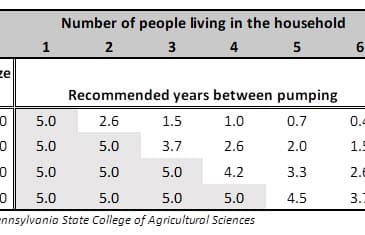Picture this: you wake up one morning, ready to start your day, only to be confronted with an unpleasant surprise. Your septic tank is full, and a foul odor permeates the air. Panic sets in as you realize that dealing with this messy issue is now at the top of your to-do list.
But fear not! In this comprehensive article, we will delve into the world of septic tanks and explore what happens when they reach their maximum capacity. Brace yourself for an informative journey that will equip you with knowledge on how to avoid septic tank problems and ensure a smoothly running system.
Discovering the Mystery: How to Know if Your Septic Tank is Full
Septic tank issues can arise unexpectedly, causing inconvenience and potential damage. One of the key steps in avoiding such problems is understanding how to determine if your septic tank is full. By being vigilant and observant, you can detect telltale signs that indicate it’s time for maintenance.
One clear indication that your septic tank may be reaching its capacity is the presence of slow-draining sinks, showers, or toilets. This occurs because when a septic tank fills up, it hinders the proper flow of wastewater through the system, resulting in sluggish drainage. If you notice water taking longer than usual to drain away or lingering in sinks and bathtubs, it could be a sign that your septic tank is nearing fullness.
In addition to slow drainage, foul odors emanating from drains and around your property can also serve as an alarm bell for an impending septic tank issue. These unpleasant smells are caused by gases released by decomposing waste in the tank. If you catch a whiff of sewage-like smells lingering indoors or outdoors, it’s crucial not to ignore them as they may indicate a full or malfunctioning septic system.
Another red flag to watch out for is lush green grass or vegetation near your drain field. While having healthy plant life may initially seem appealing, an overgrown drain field suggests that excess wastewater from a full septic tank is saturating the soil instead of being adequately absorbed underground. This oversaturation can lead to sewage backups and environmental contamination if left unaddressed.
The Culprits Behind a Full Septic Tank: Causes and Explanations
Understanding the causes behind a full septic tank is crucial in preventing potential disasters and maintaining a healthy system. Several factors contribute to the accumulation of waste, leading to an overloaded tank. The primary culprit is excessive water usage, which overwhelms the system’s capacity to process and drain efficiently. Whether it’s due to leaky fixtures, long showers, or multiple loads of laundry, every drop counts when it comes to your septic tank’s health.
Another common cause of a full septic tank is the introduction of non-biodegradable substances. Items such as wet wipes, feminine hygiene products, toilet paper that doesn’t dissolve easily, or even household chemicals can wreak havoc on your system. These materials can clog pipes and accumulate in the tank over time, obstructing normal function and leading to backups.
Poor maintenance practices also contribute significantly to septic tank issues. Neglecting regular pumping schedules allows solids to accumulate at a faster rate, ultimately leading to an overwhelmed system. Additionally, improper disposal of food waste through garbage disposals can overload the tank with organic matter that takes longer to break down than human waste.
Finally, one must not overlook the impact of tree roots on septic systems. As trees grow near drain fields or directly above pipelines connected to the septic tank itself, their roots have a tendency to infiltrate these areas in search of water and nutrients. These intruding roots can cause damage by blocking drainage paths or even breaking pipes entirely.
Say Goodbye to Septic Troubles: Remedies for a Full Septic Tank
When faced with a full septic tank, it’s crucial to take swift action to avoid any potential disasters. Fortunately, there are several effective remedies at your disposal that can alleviate the burden on your septic system and restore its functionality.
1. Regular Pumping: The foundation of a well-maintained septic system lies in regular pumping. By scheduling professional pumping services every three to five years, you can ensure that excess solids and sludge are removed from your tank, preventing blockages and minimizing the risk of backups.
2. Water Conservation: Conserving water is not only beneficial for our environment but also for your septic system’s health. Implement efficient plumbing fixtures, repair leaky faucets promptly, and practice water-saving habits such as taking shorter showers or running full loads in the dishwasher and washing machine. Less water entering your septic tank means less strain on its capacity.
3. Biological Additives: Consider using biological additives specially designed for septic systems as an extra boost for maintaining a healthy balance of bacteria inside the tank. These additives contain beneficial microorganisms that break down waste more efficiently, reducing solids accumulation and odor problems.
4. Proper Waste Disposal: Be mindful of what goes down your drains and toilets. Avoid flushing non-biodegradable items like wet wipes, feminine hygiene products, or excessive amounts of chemicals into your septic system – they can clog pipes or disrupt the delicate microbial balance within the tank. Use proper waste disposal methods to prevent unnecessary strain on your system.
A well-cared-for septic system will reward you with trouble-free operation while ensuring environmental safety. By adopting these proactive measures, you can bid farewell to septic troubles and embrace a worry-free lifestyle.

Signs in Plain Sight: Identifying a Full Septic Tank
When it comes to your septic system, knowledge is power. By being able to identify the signs of a full septic tank, you can prevent potential disasters and ensure the smooth operation of your wastewater management system. Here are some telltale signs that your septic tank may be reaching its capacity:
Foul Odors: One unmistakable sign of a full septic tank is the presence of foul odors around your property. These odors can resemble the smell of rotten eggs or sewage and may permeate through drains or linger in your yard. If you notice a persistent unpleasant smell, it’s likely time to have your septic tank inspected.
Slow Drains: Are you experiencing slow drains throughout your home? This could be an indication that your septic tank is nearing its limit. As the tank fills up, wastewater may have difficulty flowing through the system efficiently, leading to sluggish draining from sinks, showers, and toilets. Don’t ignore these warning signs as they may escalate into more serious issues if left unattended.
Sewage Backup: No homeowner wants to encounter sewage backing up into their sinks, showers, or toilets. However, when a septic tank is full or clogged, this dreadful scenario becomes a real possibility. If you notice sewage backup in any part of your plumbing system, it’s crucial to address the issue promptly before it causes extensive damage and becomes even costlier to fix.
Lush Green Patches: While lush green patches in your yard might seem like a positive sign at first glance, they can actually indicate trouble beneath the surface. When a septic tank reaches capacity and cannot properly absorb wastewater anymore, excess nutrients from untreated sewage can seep into the surrounding soil, leading to the growth of vibrant green vegetation. If you notice these patches appearing in your yard, it’s a clear sign that your septic tank is struggling and needs attention.
Recognizing these unmistakable signs of a full septic tank allows you to take proactive measures and avoid potential disasters. Regularly monitoring your system, scheduling routine inspections, and promptly addressing any issues will ensure the longevity and efficiency of your septic system while keeping unpleasant surprises at bay.
How Often is Too Often? Understanding the Frequency of Septic Tank Pumping
Regular septic tank pumping is crucial for maintaining a healthy and efficient septic system. But how often should you schedule this maintenance task? The answer depends on several factors, including household size, water usage, and the size of your septic tank.
In general, experts recommend having your septic tank pumped every 3 to 5 years. However, this interval is not set in stone and can vary depending on individual circumstances. For instance, a larger household with more occupants will naturally produce more wastewater and may require more frequent pumping.
Another factor to consider is water usage. If your household consumes water at a high rate—for example, if you frequently run multiple loads of laundry or have a large garden that requires regular irrigation—it may be necessary to pump your septic tank more often.
Furthermore, the size of your septic tank plays a significant role in determining pumping frequency. Smaller tanks have less storage capacity and therefore fill up faster than larger ones. If you’re unsure about the appropriate pumping schedule for your specific situation, it’s best to consult with a professional septic system service provider who can assess your needs accurately.
Maintaining a Healthy Septic System: Tips for Long-Term Success
A well-maintained septic system is crucial for the overall health and functionality of your home. By implementing a few simple yet effective strategies, you can ensure the longevity of your septic tank and prevent costly disasters down the line. Here are some valuable tips to help you maintain a healthy septic system for long-term success.
1. Mindful Water Usage
Conserving water not only benefits the environment but also reduces strain on your septic system. Be mindful of excessive water usage, such as running faucets unnecessarily or allowing toilets to run continuously. Repair any leaks promptly and consider installing low-flow fixtures to minimize water consumption without sacrificing comfort.
Moreover, staggering high-water usage activities can alleviate stress on your septic tank. For example, spacing out laundry loads throughout the week instead of doing them all in one day helps prevent overloading the system with excessive wastewater at once.
2. Proper Waste Disposal
The only items that should enter your septic system are human waste, toilet paper, and wastewater from household activities like bathing and dishwashing. It is essential to avoid flushing or draining harmful substances such as grease, oil, chemicals, medications, or hygiene products down the drain.
Implementing a composting or recycling routine for kitchen scraps and non-biodegradable materials will not only contribute positively to the environment but also prevent clogs and potential damage to your septic system’s delicate balance.
3. Regular Inspections
Scheduling regular inspections by professional technicians is a proactive approach that can save you from unexpected complications in the future. Experts recommend having your septic tank inspected at least every three years or more frequently if you have a larger household or experience frequent usage.
During these inspections, professionals will assess the condition of your tank, check for leaks or cracks, measure sludge and scum levels, and ensure that the drainage field is functioning optimally. Identifying potential issues early on can prevent them from escalating into major problems that require costly repairs.
4. Septic Tank Pumping
Pumping your septic tank regularly is vital to maintain its efficiency and prevent harmful buildup. This process involves removing accumulated solids and scum from the tank to restore its capacity for wastewater storage. The frequency of pumping depends on various factors like tank size, usage, and the number of occupants in your household.
Consulting a professional septic service provider can help determine the appropriate pumping schedule for your specific circumstances. By adhering to this maintenance routine, you can ensure that your septic system operates smoothly and avoid potential overflows or backups.
A well-preserved septic system not only offers peace of mind but also preserves the integrity of your property’s sanitation infrastructure. By following these tips, you can enjoy a healthy septic system for years to come while contributing towards environmental sustainability.
The Essential Pumping Process: What to Expect
When it comes to maintaining a healthy septic system, understanding the essential pumping process is crucial. Regular pumping is necessary to prevent the accumulation of solids and ensure the smooth functioning of your septic tank. Let’s delve into what you can expect when it’s time for a professional septic tank pumping.
Firstly, scheduling an appointment with a reputable septic system service provider is paramount. They will arrive with their specialized equipment, including a powerful vacuum truck that can efficiently remove the accumulated waste from your septic tank. The technician will carefully inspect the area around the tank to determine accessibility and assess any potential risks or challenges.
Once they have set up their equipment, an access point on your septic tank will be opened. This opening allows for proper connection and creates a pathway for pumping out the contents. The technician skillfully operates the vacuum hose inside the tank, utilizing its strong suction power to extract all solid waste and sludge buildup.
During this process, it is important to note that professionals prioritize safety and hygiene measures. They use gloves, protective clothing, and follow strict sanitation practices to ensure no contamination occurs during pumping. Additionally, they may take water samples from within your septic system to gauge its overall health and check for signs of any underlying issues that may require attention.
Scrub-a-Dub-Dub: Keeping Your Septic Tank Clean and Clear
Caring for your septic tank is essential to prevent costly repairs and maintain a healthy system. Regular maintenance and proper cleaning can go a long way in ensuring the longevity of your septic tank. Here are some key tips to keep your septic tank clean and clear:
Frequent Inspections
Schedule regular inspections with a professional septic tank service company. These experts will assess the condition of your tank, check for any signs of damage or blockages, and recommend appropriate measures to keep it clean. Early detection of potential issues can save you from expensive repairs down the line.
Proper Waste Disposal
Mindful waste disposal is crucial for maintaining a healthy septic system. Avoid flushing non-biodegradable materials such as diapers, paper towels, or feminine hygiene products down the toilet. These items can clog pipes and disrupt the natural breakdown process within the tank.
Water Conservation
Conserving water not only benefits the environment but also helps prolong the life of your septic system. Excessive water usage overloads the tank and reduces its ability to adequately treat waste. Implementing water-saving practices like fixing leaky faucets, installing low-flow showerheads, and opting for efficient appliances will significantly reduce strain on your septic tank.
Maintaining Your Drainfield
The drainfield plays a vital role in wastewater treatment by allowing effluent to percolate into the soil naturally. To ensure its optimal performance, avoid parking vehicles or placing heavy objects over this area as it can compact the soil, limiting absorption capacity. Additionally, planting shallow-rooted vegetation over the drainfield aids in moisture absorption while preventing erosion.
Overflow Prevention 101: Nipping Septic Tank Overflow in the Bud
Overflowing septic tanks can be a messy and costly affair, causing extensive damage to your property and risking contamination of the environment. However, with proper understanding and proactive measures, you can prevent septic tank overflow and maintain a smoothly functioning system. Let’s explore some effective strategies to nip potential septic tank overflow in the bud.
1. Regular Maintenance and Inspection
Maintaining your septic system is crucial for preventing overflow. Schedule regular inspections by a professional to ensure that all components are working optimally. They will check for any signs of wear and tear, blockages, or leaks that could potentially lead to an overflowing tank. Additionally, regular pumping of your septic tank every few years is necessary to avoid excess accumulation and potential overflow.
Furthermore, practicing good habits at home helps maintain a healthy septic system. Avoid flushing non-biodegradable items such as wipes or feminine hygiene products down the toilet as they can clog pipes leading to increased pressure on the tank.
2. Water Conservation
An overflowing septic tank can often be attributed to excessive water usage overburdening the system’s capacity. Conserving water not only helps preserve this precious resource but also prevents overload on your septic system.
Incorporate simple habits like fixing leaky faucets promptly and installing low-flow fixtures throughout your home. Be mindful of reducing water usage during laundry days by spreading loads over time rather than overwhelming the system with consecutive heavy washes. By adopting such practices, you contribute both towards environmental sustainability and safeguarding your septic tank from potential overflow.
3. Proper Waste Disposal
The types of waste introduced into a septic system significantly impact its overall health. Avoid pouring grease, oils, or harsh chemicals down the drains as they can disrupt the natural bacterial balance within the tank, leading to blockages and decreased efficiency.
Implement a solid waste management strategy by using a compost bin for organic kitchen waste and avoiding excessive use of garbage disposals. By reducing the influx of non-biodegradable materials and harmful substances into your septic tank, you mitigate the risk of overflow and promote a healthier system overall.
4. Landscaping Considerations
The placement and maintenance of your septic system’s drain field play a crucial role in preventing tank overflow. Ensure that no heavy machinery or vehicles are parked on or near the drain field area to avoid soil compaction, which could impede proper drainage.
Moreover, consider planting water-loving vegetation like trees or shrubs at an appropriate distance from the drain field. Their roots can help absorb excess moisture while providing shade to regulate soil temperature. This careful landscaping approach aids in maintaining optimal conditions for your septic system’s functionality and prevents potential overflow.
By following these diligent preventative measures, you ensure that your septic tank remains free from overflow issues, allowing it to function efficiently for years to come. Taking proactive steps not only saves you from costly repairs but also contributes towards a healthier environment.
Don’t Let the Problem Overflow: Solving Common Septic Tank Issues
When it comes to maintaining a healthy septic system, knowledge is power. Being aware of common septic tank issues and knowing how to address them can save you from potential headaches and costly repairs. Let’s explore some of the most prevalent problems that can occur with a full septic tank and discuss effective solutions.
The Dreaded Clog: Dealing with Blocked Drains
A clogged drain is one of the most frustrating issues that homeowners face when dealing with a full septic tank. This problem can cause wastewater backups, foul odors, and even damage to your plumbing system. To tackle this issue head-on, start by using a plunger or a drain snake to clear any visible blockages. If the problem persists or worsens, it may be necessary to call in professional help.
Optimistic spin: Rest assured that by promptly addressing clogged drains, you are taking proactive steps towards maintaining a smoothly functioning septic system, ultimately ensuring long-term peace of mind for you and your family.
Foul Odors: Banishing Unpleasant Smells
No one enjoys being greeted by unpleasant odors wafting from their septic system. These foul smells can permeate your property, making it difficult to enjoy your outdoor spaces or even relax indoors. The first step in tackling this issue is identifying its source; it could be due to leaks, cracks in pipes, or inadequate ventilation systems. Addressing these underlying causes will help eliminate those unwelcome scents for good.
Optimistic spin: By overcoming foul odors emanating from your septic tank, not only will you regain control over the atmosphere of your home but also create an environment that promotes harmony and well-being.
Maintenance Neglect: The Importance of Regular Pumping
One common mistake homeowners make is neglecting the regular pumping of their septic tanks. Over time, solid waste and sludge accumulate, leading to a full tank and potential system failure. Fortunately, this issue is easily preventable by scheduling routine septic tank pumpings every two to three years, or as recommended by professionals. This proactive approach will save you from costly repairs and ensure the longevity of your system.
Optimistic spin: By investing in regular septic tank maintenance, you are safeguarding the health and functionality of your household’s wastewater management system, allowing you to focus on embracing the joys of everyday life without worrying about unexpected septic mishaps.
The Perils of Tree Roots: Protecting Your Septic System
Tree roots can be a significant threat to your septic system. As they seek out moisture, roots can invade pipes and cause blockages or even ruptures. To prevent this issue, consider planting trees at a safe distance from your septic field. Regularly inspect for any signs of root intrusion and promptly address them if detected. Additionally, utilizing root barriers can help protect your system from potential damage caused by invasive tree roots.
Optimistic spin: By taking preemptive measures to shield your septic system from encroaching tree roots, you are not only preserving the integrity of your wastewater infrastructure but also cultivating an environment that promotes harmony between nature and human habitation.
Budgeting for a Smooth Operation: Understanding Septic Tank Pumping Costs
When it comes to maintaining your septic system, it’s essential to have a clear understanding of the costs involved. Taking a proactive approach to budgeting for septic tank pumping can save you from unexpected financial burdens down the line. So, let’s delve into the world of septic tank pumping costs and shed some light on this often overlooked aspect of septic system maintenance.
The Factors Influencing Pricing
Septic tank pumping costs can vary depending on several key factors. Firstly, the size of your septic tank plays a significant role in pricing. Larger tanks naturally require more time and effort to pump, resulting in higher costs. Additionally, the accessibility of your tank and its location on your property can also affect pricing. If it requires extra labor or specialized equipment to reach, expect a modest increase in expenses. Lastly, geographical location can impact pricing due to variations in local service providers and their fee structures.
The Frequency Dilemma
One question that often arises when discussing septic tank pumping costs is how frequently this service should be performed. While there are general guidelines suggesting pumping every 3-5 years, other factors come into play. Household size, water usage patterns, and even the type of waste flushed down the drains can influence how fast your tank fills up. By considering these factors alongside professional advice from septic experts, you can strike an ideal balance between avoiding unnecessary cost fluctuations and ensuring the longevity of your system.
The Cost-Effective Approach
Now that we understand the variables impacting pricing and frequency let’s explore some cost-effective strategies for managing septic tank pumping expenses effectively. One practical step is regular maintenance that includes inspections by professionals who specialize in septic systems. Detecting any issues early on can prevent more significant problems down the line, potentially saving you money in the long run. Additionally, practicing responsible water usage habits, such as conserving water and minimizing excessive wastewater generation, can help extend the time between pumping sessions.
Investment in Long-Term Savings
While septic tank pumping is an expense that homeowners must budget for periodically, it’s crucial to view it as an investment in the longevity and functionality of your septic system. Regular pumping can prevent costly repairs or complete system failures that might require extensive excavation and replacement. By taking a proactive approach and allocating funds for this essential maintenance task, you are ultimately safeguarding yourself from potential financial headaches while ensuring a smooth operation for years to come.
Conclusion
In conclusion, the importance of maintaining a well-functioning septic system cannot be overstated. By understanding the signs of a full septic tank and taking proactive measures to prevent it from reaching capacity, homeowners can avoid costly and unpleasant issues down the line. Regular pumping, proper waste disposal practices, and regular maintenance are key to keeping your septic system running smoothly. Remember, a healthy septic system means a happy home and peace of mind for years to come. So take charge of your septic tank’s health today and ensure that it remains a worry-free part of your home’s infrastructure.





